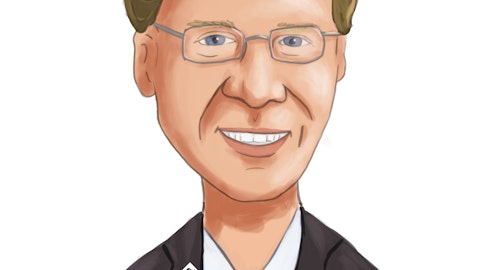Alex Paris: And then related to that, I think, on the last conference call, you said that you do annual price increases after the end of the fiscal year. So on September 1, you implemented a price increase. And those typically range from 3% to 10%, with inflation running pretty hot right now, even though, hopefully, it might have peaked. What can you say about your price increase for fiscal €˜23?
Paul Walker: So we did implement a price increase at September 1, which is the beginning of our new €“ so we actually do it, Alex, for the fiscal year, not the calendar year. So we implemented the price increase September 1. And yes, over the years, we’ve taken it up between 3% and 10%. And this year, I would say, our weighted €“ we did take prices up 10%, but then we created an opportunity for our clients to experience less of a price increase than that if they were in exchange for a multiyear commitment, and we’ve done that every year as well. So we did do a price increase. And I would say, weighted average €“ with the number of contracts we have that are multiyear now, weighted average, we probably picked up 3%-ish or so from price increases. And then there are some that will pay 10% more, especially new clients this year, we did take the prices up.
Alex Paris: Got it. And maybe a little update on the Impact Platform. I know you tested it throughout last year, and you launched it in North America in October. How €“ what are the early indications from clients on that transition?
Paul Walker: Yes. Great question. Jen Colosimo, do you want to €“ you’re in the middle of that one every day. Do you want to talk about how our clients are feeling about the Impact Platform?
Jen Colosimo: Of course. Thanks, Alex. Just as we saw during the limited launch and during our pilot phases, what clients are most impressed with is their ability to scale. The administration being taken all into the Impact Platform, they are able to really roll out, which is a big challenge for limited departments, learning and development departments that have maybe less staff for the way we can actually scale so much of this in a differential way, which has been a challenge they have been facing for decades. And so we are having tremendous conversations of clients converting, taking cohorts through it, doing the one-on-one coaching, we are seeing great success with the technology we have rolled out.
Alex Paris: Great. And what are their next steps then? I think you also said in the last conference call, over the coming months, we will roll it out to the other countries and other languages and things like that. Where are we in that process?
Jen Colosimo: Our global rollout has begun with our English-speaking direct offices, meaning the UK and Ireland and Australia, have started the global rollout. And as we take the platform into a variety of other languages, we are anticipating an April rollout globally.
Alex Paris: Great. And then my last question, I will give other people a chance, is capital allocation. A full cash flow statement is not provided in the press release. Wondering if you repurchased any shares in the first quarter? How many share €“ what is remaining on the outstanding current authorization? And what are your plans for capital allocation in general, share repurchases, dividend consideration, both regular dividend and perhaps special dividend, I think people have talked about?
Steve Young: Alex, we had about 800,000 buyback in the quarter, and that was related to the net exercise of long-term incentive plan shares. Our philosophy related to capital allocation is similar to what it’s been, where we are always looking at opportunistically buying back shares. We periodically talk about dividend, even though we are not in a position right now of pursuing that avenue. We also look at things related to acquisitions that we have talked about. So, basically, we are looking at all of those all the time, again, acquisitions, opportunistically buying back shares, maybe someday doing a dividend. And then we don’t mind having a little bit of cash on the balance sheet from time-to-time. So, we have about $20 million remaining on our authorization.
And we talk about considering all of those capital allocation uses without making commitments because we are looking at those all time and opportunistically buying back shares. But I think I can say we will periodically be in the market buying back shares.
Alex Paris: Great. Thanks Steve and thanks to everyone. I will €“ that’s the last of my questions for now. Thank you.
Paul Walker: Thank you, Alex.
Operator: Thank you. The next question comes from the line of Nehal Chokshi from Northland Capital Markets. Your line is open.
Nehal Chokshi: Alright. Thank you and congrats on a strong quarter here. Steve, how much of an incremental headwind or a tailwind was FX to the top line during the quarter relative to what you had expected a quarter ago?
Steve Young: Well, it was a $2 million impact compared to prior year. So, it’s $2 million top line, $800,000 adjusted EBITDA impact. And we could see some of that coming, but that’s what the impact was.
Nehal Chokshi: What about relative to a quarter ago?
Steve Young: A quarter ago, let’s say €“ just one second. Our revenue impact, hold on just a second, we will give you an audit quality number. Two clicks away. I don’t remember exactly what it was. $1.4 million top line and the same $800,000 adjusted EBITDA impact.
Nehal Chokshi: Okay. Great. Thank you. And Paul, so you mentioned that tech-related customers, and we see it in the headlines, a lot of layoffs, it sounds like it’s impacting, but they are not canceling contracts. Are they still going through the motions of doing renewals, especially those that are laying off employees, and it’s just simply you are not getting the level of expansion that you usually get? Can you just double-click there?
Paul Walker: Yes. I am glad you came back to that. Good question. So, a couple of things. One, and that’s not to say that there aren’t tech companies still doing business with us. In fact, the end of the first quarter, we closed a meaningful deal with a very, very large tech company who was very prominently in the news for laying-off a lot of people. And I think that highlights that even though you might let go 16,000 people, you still have 80,000 people left who need to be more effective, the culture needs to continue to make progress, etcetera, etcetera. So, my point there was, yes, so clients are still €“ we are still experiencing very nice renewal and retention rates like we have even in this environment. We had a nice new logo quarter in the first quarter.
People are still coming to our marketing events, as I said. I was just more trying to highlight that it’s a bit spotty out there, and we do see some of those headwinds, and they show up a little bit more in some places in the economies than others. And there are other industries where we are talking about very large expansions right now. There is even a couple of tech companies that were talking about large expansions because, again, they are recognizing that business doesn’t end because we are facing headwinds. We still have to figure out how to get these important things done even in this environment. Something Alex said earlier, too, just to double-click back on that is, this is different for us. We had the subscription business model now, and we are much more entrenched with our clients, generally speaking, than we were pre-subscription, and we continue to see that be the case today.





